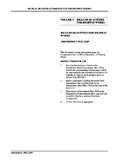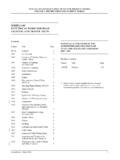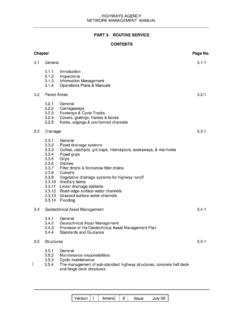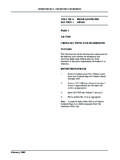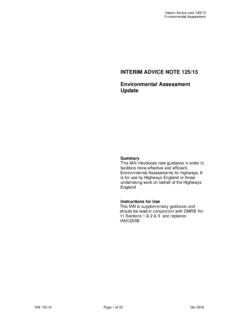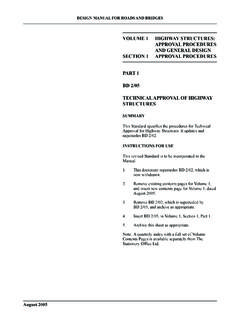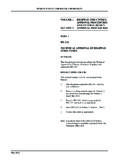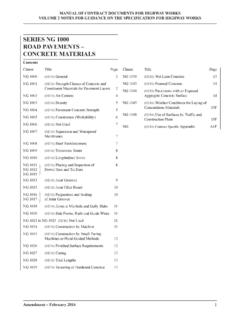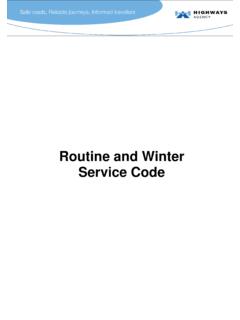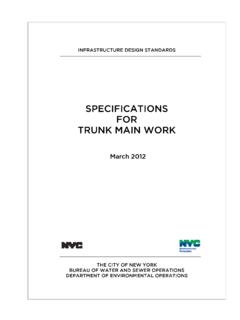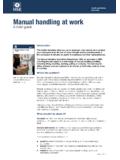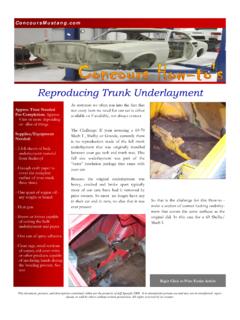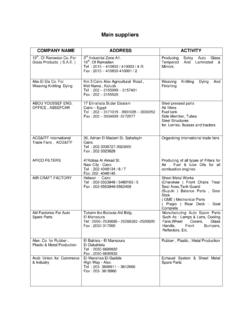Transcription of DMRB VOLUME 8 SECTION 3 - Standards for …
1 August 2007 DESIGN MANUAL FOR ROADS AND BRIDGESVOLUME 8 TRAFFIC SIGNS ANDLIGHTINGSECTION 3 LIGHTINGTD 34/07 DESIGN OF ROAD LIGHTING FOR THESTRATEGIC MOTORWAY AND ALLPURPOSE trunk ROAD NETWORKSUMMARYThis document sets out the design Standards applicableto road lighting on the strategic motorway and allpurpose trunk road FOR contents pages from VOLUME 8 and insertnew contents pages dated August new Advice Note TD 34/07 into VOLUME 8, SECTION archive this sheet as : A quarterly index with a full set of VolumeContents Pages is available separately from TheStationery Office 34/07 VOLUME 8, SECTION 3,Design of Road Lighting for theStrategic Motorway and AllPurpose trunk Road NetworksDESIGN MANUAL FOR ROADS AND BRIDGESTHE HIGHWAYS AGENCYTRANSPORT SCOTLANDWELSH ASSEMBLY GOVERNMENTLLYWODRAETH CYNULLIAD CYMRUTHE DEPARTMENT FOR REGIONAL DEVELOPMENTNORTHERN IRELANDS ummary:This document sets out the design Standards applicable to road lighting on thestrategic motorway and all purpose trunk road 8 SECTION 3TD 34/07 August 2007 REGISTRATION OF AMENDMENTSA mendPage NoSignature & Date ofAmendPage NoSignature & Date ofNoincorporation ofNoincorporation ofamendmentsamendmentsRegistration of AmendmentsVolume 8 SECTION 3TD 34/07 August 2007 REGISTRATION OF AMENDMENTSA mendPage NoSignature & Date ofAmendPage NoSignature & Date ofNoincorporation ofNoincorporation ofamendmentsamendmentsRegistration of AmendmentsVOLUME 8 TRAFFIC SIGNS ANDLIGHTINGSECTION 3 LIGHTINGTD 34/07 DESIGN OF ROAD LIGHTING FOR THESTRATEGIC MOTORWAY AND ALLPURPOSE trunk ROAD Prior to AList of ConsulteesAppendix BLighting Design ChecklistDESIGN MANUAL FOR ROADS AND BRIDGESA ugust 2007 VOLUME 8 SECTION 3TD 34/07 August 20071/1 Chapter 1 Introduction1.
2 Standard contains requirements andguidance for the design of road lighting on the strategicmotorway and all purpose trunk road network, referredto hereafter as the strategic road network. publication of the new European and BritishStandards BS EN 13201 Road Lighting and BS 5489 Code of Practice for the Design of Road Lighting in2003 introduced significant changes to road lightingdesign criteria. This has necessitated the revision ofTD 30/87 Design of Road Lighting for All-PurposeTrunk Roads and TD 34/91 Design of Road Lightingfor Motorway trunk Roads. These covered similartopics and this revised Standard consolidates them intoone standard for the design of road lighting on thestrategic road 5489 contains guidance and recommendationsto support BS EN 13201 and to enable designers ofroad lighting schemes to comply with it. This Standarddescribes how to apply BS EN 13201 and BS 5489 tothe design of road lighting for the strategic Standard should be read in conjunction withTA 96 Whole Life Cycle Code of Practice for Lightingon the Strategic Motorway and All Purpose trunk Standard sets out the design objectives andprocedures that shall be adopted for the design of roadlighting for the strategic road following aspects of road lighting are notincluded in this decision whether or not to provide roadlighting (refer to TA 49 Appraisal of New andReplacement Lighting on the Strategic Motorwayand All Purpose trunk Road Network); design of lighting for long and short roadtunnels (refer to BS 5489-2 Code of Practice forthe Design of Road Lighting Part 2: Lighting ofTunnels and BD 78 Design of Road Tunnels); lighting levels and hours of operation(further advice on this subject will be availablefrom the Highways Agency from 2008).
3 Specification that is not directlyrelated to photometric performance (refer toother Standards and the relevant clauses fromMCHW-1); lighting power distribution Standard shall be used forthwith for thedesign of road lighting for the strategic road network. Itshall be applied to both new lighting schemes andrenewals where lighting columns are to be a scheme is already under construction orcurrently being prepared and application of thisStandard would result in significant additional cost ordelay, the advice of the Overseeing Organisation shallbe this Standard the definitions in the followingstandards shall EN 13201-2 Road Lighting Part 2:Performance Requirements; 5489-1 Code of Practice for the Design ofRoad Lighting Part 1: Lighting of Roads andPublic Amenity 8 SECTION 3TD 34/07 August 20072/1 Chapter 2 Performance Requirements2. PERFORMANCE road lighting shall be designed in accordancewith the recommendations of BS 5489-1 Code ofPractice for the Design of Road Lighting Part 1:Lighting of Roads and Public Amenity Areas, togetherwith the additional requirements set out in road lighting shall be designed and installedsuch that the installation will emit no direct light abovethe horizontal.
4 Criterion for lighting main carriageways onthe strategic road network is luminance based. The aimis to achieve a bright background (the road surface),with acceptable uniformity and glare, against whichobjects appear in silhouette. The lighting shall complywith the quantifiable system performance requirementsset out in paragraphs and to criterion for lighting conflict areas on thestrategic road network, such as junctions, complex roadintersections, roundabouts and queuing areas, isilluminance based. The lighting shall comply with thequantifiable system performance requirements set out inparagraphs to road lighting should comply with thesubjective performance requirements set out inparagraphs to , so far as is arrangements for the strategic roadnetwork should generally be as described in of BS 5489-1, subject to the both in use and during maintenance is ofparamount importance (see Chapter 3 of thisStandard); andiicatenary lighting is only permitted in exceptionalcircumstances where it can be demonstrated thatit is the only practical System Performance Carriageways (strategic road network) lighting design shall be in accordance withthe recommendations of Clause 7 and Annex B ofBS 5489-1.
5 The design objectives for the lightingof main carriageways are expressed inperformance terms using the five calculatedphotometric measures of maintained averageluminance, overall uniformity, longitudinaluniformity, threshold increment and design shall be based on dry road conditionsand shall use the ME-series of lighting classesgiven in Table 1a of BS EN 13201-2. The wetroad MEW-series of lighting classes given inTable 1b of BS EN 13201-2 should not be usedunless specified by the Overseeing carriageways carriageways of motorways, dualcarriageway roads and single carriagewayroads; roads and free flow link roads atgrade-separated junctions andinterchanges, provided horizontal andvertical alignment complies with TD 9,including permitted relaxations; shoulders where the OverseeingOrganisation foresees hard shoulderrunning in the near shoulders (emergency lanes) shall bedesigned in accordance with Sub-Clause ofBS 5489-1. Where the hard shoulder is partcarriageway and part hardened verge this appliesto the carriageway part only, the hardened vergebeing covered by the surround that are no wider than one metre maybe ignored as they should be covered by thesurround 8 SECTION 3TD 34/07 August 20072/2 Chapter 2 Performance a portion of the carriageway is providedwith hatchings and other road markings thedesign should nevertheless include the lighting design shall comply with Clause 11and Annex B of BS 5489-1.
6 The designobjectives for the lighting of conflict areas areexpressed in performance terms using the threecalculated photometric measures of maintainedaverage horizontal illuminance, overalluniformity and glare design shall use the CE-series of lightingclasses given in Table 2 of BS EN areas level junctions, includingapproaches; carriageways and approachesof roundabouts and gyratories; junctions andinterchanges, except those elementscovered by paragraph ; plazas, between the points where thecarriageway is widened; points for non-motorized users; other areas of potential conflict asagreed with the Overseeing a lit slip road or link road joins a litmainline, the resulting conflict point should betreated as described in paragraph on the strategic road network shouldnormally comply with luminous intensity class G6 asgiven in Table of BS EN 13201-2 in order to limitenvironmental impact. However, in rare instancesenvironmental significance may be less important thanother considerations, in which case the constraints onluminous intensity for angles below the horizontal maybe relaxed, subject to the agreement of the The lighting of bridges and elevated roads shallbe in accordance with Clause 8 of BS Road lighting close to other modes of transportshall be in accordance with Clause 12 of BS Performance The design of road lighting should follow therecommendations in Clauses 4 and 5 of BS The lighting arrangement should be coordinatedwith any bridges, gantries, traffic signing, signallingand surveillance installations so as to minimizeshadows and visual Appearance will be influenced by the colour andbrightness of light sources at night and by the scale,form and disposition of luminaires and their supports inthe daytime.
7 Views from surrounding areas may be asimportant as views for road Bracket projections should comply with therecommendations of Sub-Clause of BS 5489-1and additionally should not exceed metres formounting heights up to and including 8 metres, and2 metres for all other mounting heights. Brackets shouldbe inclined slightly upwards at an angle not exceeding5 and the spigot should be designed to enablecompliance with paragraph Performance The ingress protection rating for luminaireoptical compartments should preferably be IP 6X asdefined in BS EN 60529, but shall in any case complywith the minimum requirements given in Cl inMCHW-1 Series 1400 Electrical Work for RoadLighting and Traffic Luminaire control gear shall be of the dimmableelectronic type wherever 8 SECTION 3TD 34/07 August 20073/1 Chapter 3 Decisions Prior to Design3. DECISIONS PRIOR TO decisions that need to be made prior todesign are set out in Clauses 4, 5 and 6 of BS 5489 chapter of the Standard sets out the additionalrequirements applicable to the strategic road sources shall have a colour rendering index(Ra) greater than or equal to 20 and shall be selected tominimise whole life cost and energy Arrangement and Column lighting arrangement shall ensure that accessfor maintenance is as safe as reasonably recommendations in IAN 69 Designing forMaintenance should be roads with a mandatory speed limit of50 mph or more the distance of lighting columns fromthe carriageway shall be determined in accordance withTD 19 Requirement for Road Restraint Systems.
8 Forother roads the distance from the carriageway shall beno less than specified in Table 2 of BS 5489-1 and theguidance given in TD 19 for such roads shall passively safe lighting columns areproposed (as an alternative to providing a dedicatedroad restraint system), the distance from thecarriageway shall be in accordance with therecommendations of Chapter 5 of TA 89 Use ofPassively Safe Signposts, Lighting Columns and TrafficSignal Posts to BS EN of Lighting of the applicable lighting class fromTable of BS 5489-1 shall be made using thefollowing average daily traffic flow (ADT) is theopening year ADT (ADT is defined as the totaltraffic in both directions during a given period, inwhole days, divided by the number of days in thegiven period). motorways, the distance between junctions ismeasured from the end of the entry slip roadtaper to the beginning of the next exit slip road surface luminance, used in designingthe lighting for the main carriageway, is dependent onthe reflection properties of the road surface.
9 The roadsurface obtains its luminance by the process ofillumination and reflection and therefore the roadsurface becomes a component of the road on selection of the appropriate roadsurface reflection data is given in Sub-Clause ofBS factors shall be determined inaccordance with Sub-Clause of BS maintenance factors shall be selected fromTable of BS The requirements for lamp changing andluminaire cleaning are set out in TD 23 trunk Roadsand trunk Road Motorways Inspection andMaintenance of Road Electricity Supply Safe working clearance shall be ensured on allroad lighting near overhead electricity supply lines. Theoperator of the line shall be consulted regarding safeworking clearances and to establish the accurateposition and height of the The design should seek to minimise the numberof affected lighting columns. Lower mounting heightsshould be used as needed and columns should normallybe hinged in order to provide safe access formaintenance in the vicinity of the overhead 8 SECTION 3TD 34/07 August 20073/2 Chapter 3 Decisions Prior to DesignExtent of When a SECTION of road is lit, any single leveljunctions, grade separated junctions and interchangesoccurring within or at either end should also be Grade-separated junctions where the mainline isunlit unlit; partially lit, with only the off-line conflictpoints lit (see paragraph ); fully lit, with lighting provided on themainline through the junction and on the sliproads (see paragraph ).
10 Grade-separated junctions situated at the end of alit SECTION of mainline may partially lit, with mainline lighting terminatedjust beyond the back of nose of the slip roadsconnecting to the lit SECTION , lighting continuingalong the full length of those slip roads, and theslip roads connecting to the unlit side of thejunction remaining unlit; fully lit, with lighting on the mainlineextended through the junction and on the Lighting on slip roads, link roads and auxiliarylanes should extend to the end of the taper, and themainline lighting should continue for a further distanceno less than times the Desirable Minimum StoppingSight Distance as defined in TD Lighting on the leaving or joining lane of a lanedrop/lane gain junction should extend to the pointwhere the mainline carriageway width becomesconstant, and the mainline lighting should continue fora further distance no less than times the DesirableMinimum Stopping Sight For single
